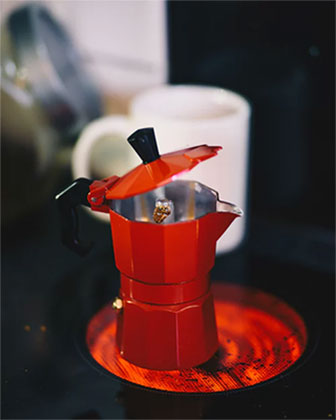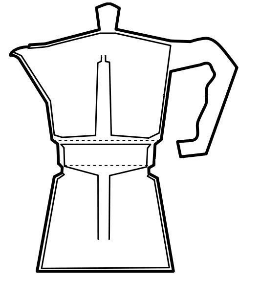An iconic Italian coffee machine: knowing the story of Moka Pot

Almost all of us have used it on vacation, camping or in our country house, and it also has its own fanatical friends: we're talking about "Moka Pot", or as we usually call it in Greek, "espresso pot".
For many, it was their first contact with a coffee other than the filter coffee , Greek coffee or Frappe, at a time when home espresso machines were all but common. The "espresso briquette" or "moka pot" is easy to use, extremely stylish and produces a very delicious espresso-like coffee. Despite the spread of espresso machines, Moka Pot still has lots of fans and an almost cult following among coffee lovers because of its practicality and convenience, its beautiful design and the possibilities it offers for experiments and interventions in the brewing process.
Moka Pot's origin and history
 The Moka Pot has its roots in interwar Italy since it was invented in 1933 by the Italian engineer Luigi de Pont, although the man responsible for its dissemination is no one but Alfonso Bialetti. Alfonso Bialetti bought Pont's designs, patented them and redesigned the coffee maker using two then innovative materials: aluminum and bakelite. He named the new "Moka" device from the Yemeni homonym harbor, formerly the center of world coffee trade.
The Moka Pot has its roots in interwar Italy since it was invented in 1933 by the Italian engineer Luigi de Pont, although the man responsible for its dissemination is no one but Alfonso Bialetti. Alfonso Bialetti bought Pont's designs, patented them and redesigned the coffee maker using two then innovative materials: aluminum and bakelite. He named the new "Moka" device from the Yemeni homonym harbor, formerly the center of world coffee trade.
Moka Pot's design has made it not only iconic for Italian coffee culture but also for industrial design in general. A sample of the Italians' love for this briquette is that they call it simply "Il Caffetiera", but also the fact that it is not lacking from any Italian cuisine and is widely spread across Europe. Its design is both pioneering and classic, absolutely indicative of both his era and the Italian coffee culture, with the result that the Moka Pot is an exhibit at many museums dedicated to design and industrial design such as the Design Museum of London, the Cooper - Hewitt Museum in New York, the London Museum of Science and the New York City Museum of Modern Art. It is impressive and indicative of the popularity of the device, the fact that while Moka Pots are now being manufactured by various companies around the world, very few things have changed in relation to their design, which is almost the same as that they had eighty years ago .
How does Moka Pot work?
The espresso machine consists of three parts: the water chamber, the filter in which the ground coffee is placed and the top, where the extracted coffee is concentrated. After putting ground coffee on the filter, fill the chamber with water and place the breadcrumbs on a heat source, which can be either a gasp or a kitchen eye. The steam produced rises upward through a small tube, passes through the coffee beans and the extracted coffee is concentrated on the top of the birch, which has a special spout for easy coffee serving.
Depending on the model and the company that produces it, there may be minor differentiations in the design, which however do not affect the basic functions of the briquette. The main feature that differentiates some moka pots from others is the pressure valve, operating in the same way that a pressure cooker works and allows pressure to be created inside the brute.
Which coffee is suitable for a Moka Pot;
 There are no restrictions on the coffee we can use in a Moka Pot. Any blend, regardless of its intensity, its composition or its degree of roasting, can give remarkable results in a moka pot. What matters is the grinding deegree as connoisseurs advise that coffee should be a little coarser than the corresponding espresso grinding in order to get the best results from our briquette. In general, we choose the coffee we will use depending on the properties we want to have our cup (a robusta rich blend will help create better crema).
There are no restrictions on the coffee we can use in a Moka Pot. Any blend, regardless of its intensity, its composition or its degree of roasting, can give remarkable results in a moka pot. What matters is the grinding deegree as connoisseurs advise that coffee should be a little coarser than the corresponding espresso grinding in order to get the best results from our briquette. In general, we choose the coffee we will use depending on the properties we want to have our cup (a robusta rich blend will help create better crema).
Can the coffee brewed for a moka pot be classified as espresso?
It is worth noting that according to the classic Italian definition of espresso, coffee extracted from a Moka Pot can not be described as an espresso, since the definition requires extraction at a pressure of at least 9 bar, while Moka Pots are impossible to produce a pressure greater than 2 bar. However, there is no doubt that the taste, as well as the appearance of coffee, is closer to that of espresso than any other extraction method. There are several tips that have to do with the control of various factors, such as coffee tamping, its degree of grinding, water temperature and extraction time, so that coffee reminds as much as possible of espresso. Moka Pots fans share tips and techniques in online communities and video tutorials, which reveals the love that feeds a lot of coffee enthusiasts for this simple, aluminum device.
If you really love espresso, the Moka Pot will not of course make you change your mind. But it does not cease to be a decent solution for all those times you are away from your favorite espresso machine - it's also a very stylish device that will give your Italian color to your kitchen but also a tool that will allow you to experiment with different ways of extraction. Anyway, coffee for us is passion no matter how it is extracted!







